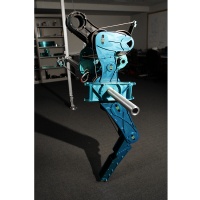The Electric Cable Differential (ECD) Leg is designed for running, walking, jumping, hopping, and generally behaving in a highly dynamic manner. Large fiberglass springs are used for storing the energy of a running gait, much like the springs in a pogo stick or the tendons in a kangaroo. The name “ECD Leg” is derived from the method of actuation and power transmission; we use electric motors, which offer much simpler and more precise computer control than pneumatic or hydraulic actuators. The motors are connected to the leg joints using steel cable wrapped around aluminum pulleys, and there are several mechanical differentials to implement the desired relationship between the electric motors, fiberglass springs, and leg joints.
There are currently two robots built using ECD Legs: A monopod, named Thumper, installed here at the Robotics Institute, and a biped, named MABEL, installed in professor Jessy Grizzle’s laboratory at the University of Michigan. Thumper will be used to explore the role of compliance in a running gait, while MABEL will be used to explore control theory for legged locomotion.
The ECD Leg is the final revision of the prototype BiMASC (see farther down on this page).

|
Videos, with the most recent at the top of the list: Self-balanced hopping(Quicktime, 17MB) The robot falling many times (AVI, 415MB) Unstable but interesting (AVI, 43MB) Simple PD control of the ECD Leg (Mpeg-1, 4MB) Trajectory following of the ECD Leg (Mpeg-1, 3.4MB) Video of assembly (AVI, 9mb) Some publicity: article from Carnegie Mellon main web site, www.cmu.edu
|

|
BiMASC: Biped with Mechanically Adjustable Series ComplianceWe are designing and building the Biped with Mechanically Adjustable Series Compliance, or BiMASC, to be capable of running, walking, jumping, hopping, and generally behaving in a highly dynamic manner. The actuation is based on the AMASC, which provides tunable passive dynamics for efficient and stable locomotion. Some publicity: Machine Design Magazine cover
|





